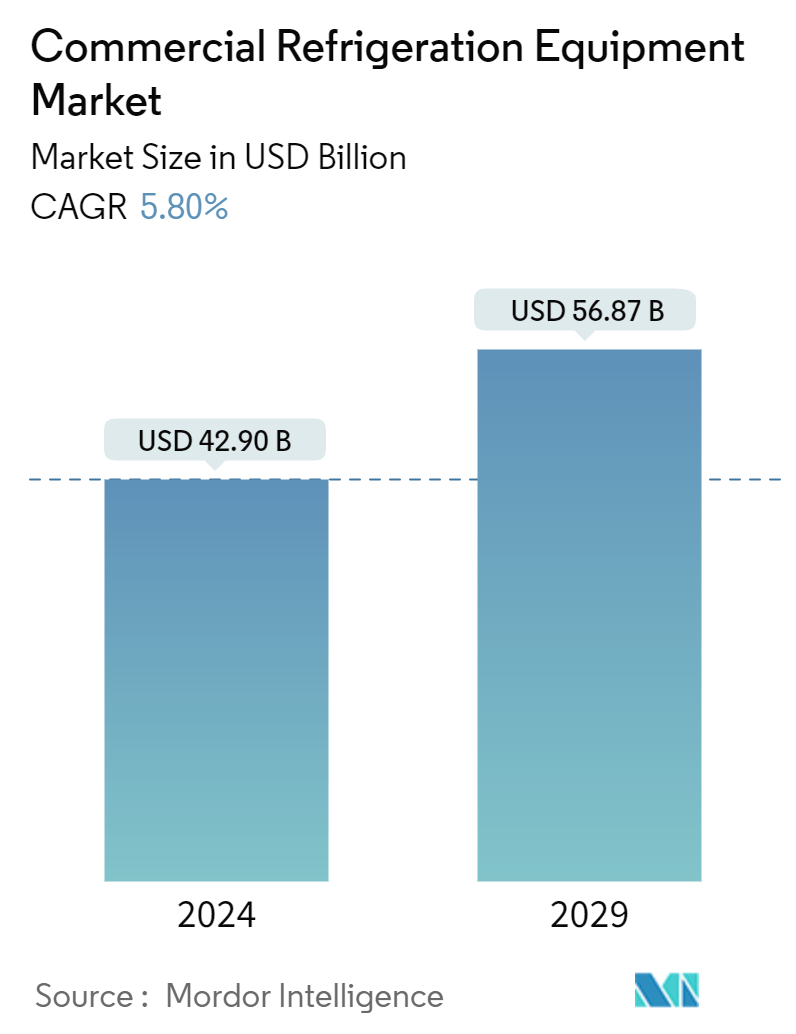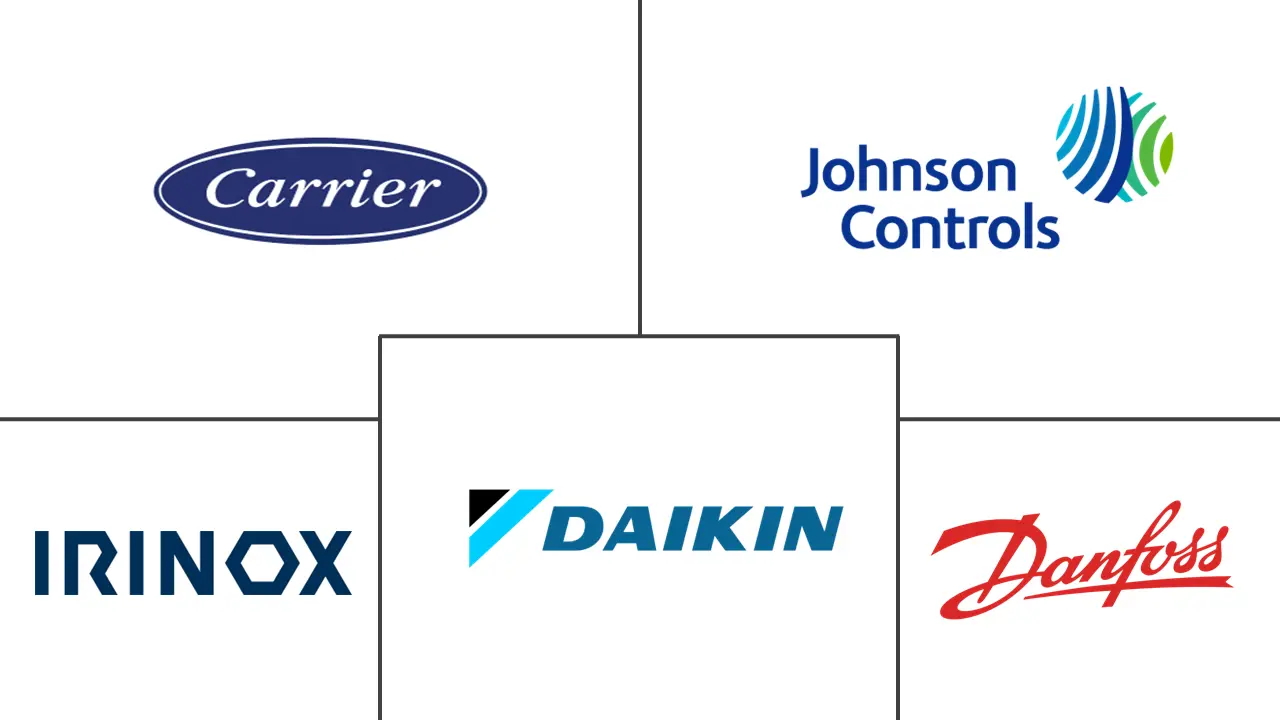Market Size of Commercial Refrigeration Equipment Industry

| Study Period | 2022 - 2029 |
| Market Size (2024) | USD 42.90 Billion |
| Market Size (2029) | USD 56.87 Billion |
| CAGR (2024 - 2029) | 5.80 % |
| Fastest Growing Market | Asia Pacific |
| Largest Market | North America |
Major Players
*Disclaimer: Major Players sorted in no particular order |
Commercial Refrigeration Equipment Market Analysis
The Commercial Refrigeration Equipment Market size is estimated at USD 42.90 billion in 2024, and is expected to reach USD 56.87 billion by 2029, growing at a CAGR of 5.80% during the forecast period (2024-2029).
- The commercial refrigeration equipment market is expected to grow during the forecast period due to the rapid expansion of the hospitality and tourism sector and consumers' increasing preference for takeaway meals. The market will also benefit from adopting refrigerants with lower global warming potential and ongoing technological advancements driven by regulatory pressures and environmental considerations.
- Commercial refrigeration equipment sales are influenced by various factors, including an increase in international food trade activity, rising investments in the food and beverages industry, growing demand from pharmaceutical and drug industries, advancements in technology, an increasing need for cold storage services, rising demand for industrial refrigerators, and the fast-growing hospitality sector. The lifestyle and eating habits of individuals worldwide have undergone significant changes in recent years, leading to a substantial rise in the demand for frozen and packaged foods, consequently driving the potential of the commercial refrigeration equipment market.
- Integrating innovative and IoT-enabled features is increasingly popular as refrigerators, freezers, and chillers are equipped with sensors, connectivity, and data analytics. This enables convenient remote monitoring, predictive maintenance, and performance optimization. A prime example is iMatrix Systems, an industrial Internet of Things (IIoT) technology company that introduced innovative products aimed at helping restaurants ensure food safety and minimize food waste.
- However, commercial refrigeration systems are commonly utilized in demanding applications due to their high efficiency. These systems use commercial-grade refrigerants specifically designed to comply with government regulations. Moreover, the prices of these systems are relatively high to meet industry standards. Consequently, acquiring these expensive refrigeration systems necessitates a substantial initial investment. At the same time, maintaining such large-scale equipment may pose challenges to the widespread adoption in various industries.
- Multiple macroeconomic factors, such as fluctuations in energy prices, can impact the operational costs of refrigeration equipment, influencing the market demand for energy-efficient models. Also, global supply chain issues, including those caused by geopolitical tensions, can affect the availability and cost of refrigeration equipment components and finished products.
Commercial Refrigeration Equipment Industry Segmentation
For market estimation, the revenue generated from selling commercial refrigeration products offered by different market players for various applications is used. Market trends are evaluated by analyzing product innovation, diversification, and expansion investments. Further, advancements in food and beverages, retail, chemicals, healthcare, and pharmaceutical applications are crucial in determining the market's growth.
The commercial refrigeration equipment market is segmented by product type (blast chillers, refrigerators, and freezers, transportation refrigeration, refrigerated display cases, beverage refrigeration, ice cream freezer, and refrigerated vending machine), refrigerant type (fluorocarbons, hydrocarbons, and inorganics), application ((food & beverages [food service & distribution, hotels & restaurants, and bakeries], retail [supermarkets & hypermarkets and convenience stores], chemicals and healthcare & pharmaceuticals)), and geography (North America, Europe, Asia-Pacific, Middle East & Africa, and Latin America). The market sizes and forecasts are provided in terms of value (USD) for all the above segments.
| By Product Type | |
| Blast Chillers | |
| Refrigerator and Freezer | |
| Transportation Refrigeration | |
| Refrigerated Display Cases | |
| Beverage Refrigeration | |
| Ice Cream Freezer | |
| Refrigerated Vending Machine | |
| Other Product Types |
| By Refrigerant Type | |
| Fluorocarbons | |
| Hydrocarbons | |
| Inorganics |
| By Application | ||||||
| ||||||
| ||||||
| Chemicals | ||||||
| Healthcare & Pharmaceuticals | ||||||
| Other Applications |
| By Geography*** | |
| North America | |
| Europe | |
| Asia | |
| Australia and New Zealand | |
| Middle East and Africa | |
| Latin America |
Commercial Refrigeration Equipment Market Size Summary
The commercial refrigeration equipment market is poised for significant growth over the forecast period, driven by the expanding hospitality and tourism sectors and a shift in consumer preferences towards takeaway meals. The market is also benefiting from the adoption of refrigerants with lower global warming potential and technological advancements spurred by regulatory and environmental pressures. Key factors influencing market dynamics include increased international food trade, rising investments in the food and beverage industry, and growing demand from the pharmaceutical sector. The integration of IoT-enabled features in refrigeration systems is becoming more prevalent, allowing for remote monitoring and predictive maintenance, which enhances operational efficiency and food safety.
The Asia-Pacific region is expected to witness substantial market expansion due to rising demand for frozen food products and the thriving travel and tourism industry in countries like Malaysia, Indonesia, and Singapore. Urbanization and increased disposable income in China are driving the demand for high-quality food storage solutions. The market is highly competitive, with major players like Carrier Global, Johnson Controls, and Daikin Industries Ltd. focusing on expanding their global presence through collaborations and innovative product offerings. Recent strategic moves, such as acquisitions and partnerships, aim to enhance market positions and drive revenue growth. The market's growth is further supported by the increasing reliance on cold chain processes in the organic food sector and the expanding number of supermarkets and hypermarkets in the region.
Commercial Refrigeration Equipment Market Size - Table of Contents
-
1. MARKET INSIGHTS
-
1.1 Market Overview
-
1.2 Industry Attractiveness - Porter's Five Forces Analysis
-
1.2.1 Threat of New Entrants
-
1.2.2 Bargaining Power of Buyers/Consumers
-
1.2.3 Bargaining Power of Suppliers
-
1.2.4 Threat of Substitute Products
-
1.2.5 Intensity of Competitive Rivalry
-
-
1.3 Technology Snapshot
-
1.4 Impact of COVID-19 Aftereffects and Other Macroeconomic Factors on the Market
-
-
2. MARKET SEGMENTATION
-
2.1 By Product Type
-
2.1.1 Blast Chillers
-
2.1.2 Refrigerator and Freezer
-
2.1.3 Transportation Refrigeration
-
2.1.4 Refrigerated Display Cases
-
2.1.5 Beverage Refrigeration
-
2.1.6 Ice Cream Freezer
-
2.1.7 Refrigerated Vending Machine
-
2.1.8 Other Product Types
-
-
2.2 By Refrigerant Type
-
2.2.1 Fluorocarbons
-
2.2.2 Hydrocarbons
-
2.2.3 Inorganics
-
-
2.3 By Application
-
2.3.1 Food & Beverages
-
2.3.1.1 Food Service & Distribution
-
2.3.1.2 Hotels & Restaurants
-
2.3.1.3 Bakeries
-
2.3.1.4 Other Applications
-
-
2.3.2 Retail
-
2.3.2.1 Supermarkets & Hypermarkets
-
2.3.2.2 Convenience Stores
-
2.3.2.3 Other Retail Stores
-
-
2.3.3 Chemicals
-
2.3.4 Healthcare & Pharmaceuticals
-
2.3.5 Other Applications
-
-
2.4 By Geography***
-
2.4.1 North America
-
2.4.2 Europe
-
2.4.3 Asia
-
2.4.4 Australia and New Zealand
-
2.4.5 Middle East and Africa
-
2.4.6 Latin America
-
-
Commercial Refrigeration Equipment Market Size FAQs
How big is the Commercial Refrigeration Equipment Market?
The Commercial Refrigeration Equipment Market size is expected to reach USD 42.90 billion in 2024 and grow at a CAGR of 5.80% to reach USD 56.87 billion by 2029.
What is the current Commercial Refrigeration Equipment Market size?
In 2024, the Commercial Refrigeration Equipment Market size is expected to reach USD 42.90 billion.

